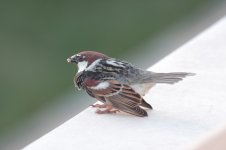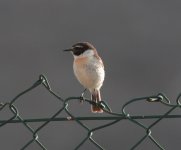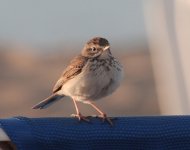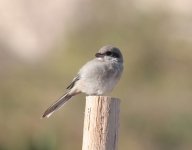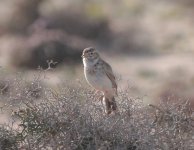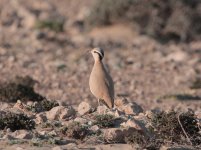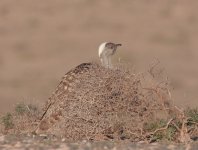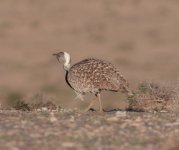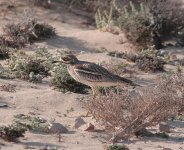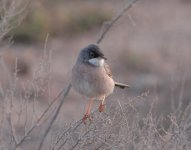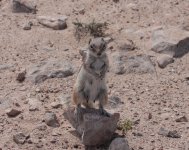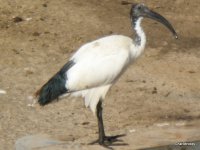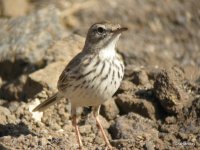davidg
Well-known member
Wednesday 10th March
I'm not sure why we chose Jandia as the resort to stay in (to be honest, I'm not sure why we chose Fuerteventura!) but for a non-birding trip it worked out rather well. The resort is in the far south of the island, about an hour and a half by coach from the airport, and is favoured by German tourists to such an extent that a knowledge of German is probably more useful there than a knowledge of Spanish. The hotel was massive and rather impersonal but the rooms were clean and we had a large, south-facing balcony giving views of the sea to the east, the mountains to the west and of the zoo belonging to another hotel to the south. More of that later...
The first birds seen on the island were inevitably Collared Doves seen from the transfer coach; two very large raptors soaring high above the desert might well have been Egyptian Vultures but were too far away to make out any features.
Monk's Parakeets and Spanish Sparrows were in the hotel grounds in some numbers; the parakeets nesting in palm trees a couple of hundred yards away and the sparrows seemingly nesting in the hotel buildings somewhere. In amongst the Monk's were a few Ring-necked Parakeets, easily told in flight by the long tail feathers.
The zoo also made its presence felt in the form of Sacred Ibis, Crowned Crane, Cattle Egrets and another Ibis species I couldn't identify regularly flying around the hotel and town. Wonderful birds, just not in the right place!
A late afternoon walk around the resort added Yellow-legged and Lesser Black-backed gulls, Raven, Kestrel and Blackcap to the slowly growing trip list.
Thursday 11th March
An early start with a walk up the 'barranco' or dry valley behind the hotel. My route took me past another hotel where an unfamiliar dove flew up into a palm tree - I took a few pictures and identified it later as Laughing Dove. I've seen this species reported by others here - does anyone know if it is a native, or is it another zoo escapee?
My first target bird appeared shortly afterwards - unexpectedly it was a Ruddy Shelduck flying over, calling. This was to be the only wetland species seen all trip. Several Ravens flew about above the mountains and after an hour of unproductive walking I gave up and started back down the barranco. An unfamiliar call drew my attention to a small bird sitting on a fence a few yards away - my first Canary Islands Chat, a female. As I watched it another bird ran across the ground in front of me, my first Berthelot's Pipit! I got my camera ready and, sure enough, both birds immediately flew off. I sat down near the fence to wait and within a few minutes a male chat appeared and showed off beautifully, allowing me to get some reasonable photos. At one stage three birds were showing, the male and two females.
Happy to have started the holiday with three early ticks I set off back to the hotel adding two Southern Grey Shrikes to my list as I went.
Breakfast proved to be more exciting than breakfasts normally are when looking across the sea from our balcony I saw what appeared to be a plume of spray several hundred yards out from shore, then another, and another. At least 20 whales were swimming past and through binoculars I could see that after each blow a dark back and small fin rolled through the sea. I estimated them to be perhaps 20 feet long, can anyone suggest a likely species? The whales stayed for 2 days and I guess were attracted by shoals of fish as there was lots of seabird activity on these two days as well.
We decided to walk to the beach for a closer look but were disappointed as of course the view from the vantage point of the hotel was far better than that at sea level. There is a boardwalk stretching from the main street to the beach which cuts through about a hundred yards of scrubby vegetation. We stopped to watch some Monk's Parakeets tearing off bits of dead plant for nesting materials and I managed a few good photographs. Whilst watching them two warblers appeared amongst the scrub and I realised I was looking at another of my target species, Spectacled Warbler. Unfortunately they flew off again before I could get the camera on them.
I'm not sure why we chose Jandia as the resort to stay in (to be honest, I'm not sure why we chose Fuerteventura!) but for a non-birding trip it worked out rather well. The resort is in the far south of the island, about an hour and a half by coach from the airport, and is favoured by German tourists to such an extent that a knowledge of German is probably more useful there than a knowledge of Spanish. The hotel was massive and rather impersonal but the rooms were clean and we had a large, south-facing balcony giving views of the sea to the east, the mountains to the west and of the zoo belonging to another hotel to the south. More of that later...
The first birds seen on the island were inevitably Collared Doves seen from the transfer coach; two very large raptors soaring high above the desert might well have been Egyptian Vultures but were too far away to make out any features.
Monk's Parakeets and Spanish Sparrows were in the hotel grounds in some numbers; the parakeets nesting in palm trees a couple of hundred yards away and the sparrows seemingly nesting in the hotel buildings somewhere. In amongst the Monk's were a few Ring-necked Parakeets, easily told in flight by the long tail feathers.
The zoo also made its presence felt in the form of Sacred Ibis, Crowned Crane, Cattle Egrets and another Ibis species I couldn't identify regularly flying around the hotel and town. Wonderful birds, just not in the right place!
A late afternoon walk around the resort added Yellow-legged and Lesser Black-backed gulls, Raven, Kestrel and Blackcap to the slowly growing trip list.
Thursday 11th March
An early start with a walk up the 'barranco' or dry valley behind the hotel. My route took me past another hotel where an unfamiliar dove flew up into a palm tree - I took a few pictures and identified it later as Laughing Dove. I've seen this species reported by others here - does anyone know if it is a native, or is it another zoo escapee?
My first target bird appeared shortly afterwards - unexpectedly it was a Ruddy Shelduck flying over, calling. This was to be the only wetland species seen all trip. Several Ravens flew about above the mountains and after an hour of unproductive walking I gave up and started back down the barranco. An unfamiliar call drew my attention to a small bird sitting on a fence a few yards away - my first Canary Islands Chat, a female. As I watched it another bird ran across the ground in front of me, my first Berthelot's Pipit! I got my camera ready and, sure enough, both birds immediately flew off. I sat down near the fence to wait and within a few minutes a male chat appeared and showed off beautifully, allowing me to get some reasonable photos. At one stage three birds were showing, the male and two females.
Happy to have started the holiday with three early ticks I set off back to the hotel adding two Southern Grey Shrikes to my list as I went.
Breakfast proved to be more exciting than breakfasts normally are when looking across the sea from our balcony I saw what appeared to be a plume of spray several hundred yards out from shore, then another, and another. At least 20 whales were swimming past and through binoculars I could see that after each blow a dark back and small fin rolled through the sea. I estimated them to be perhaps 20 feet long, can anyone suggest a likely species? The whales stayed for 2 days and I guess were attracted by shoals of fish as there was lots of seabird activity on these two days as well.
We decided to walk to the beach for a closer look but were disappointed as of course the view from the vantage point of the hotel was far better than that at sea level. There is a boardwalk stretching from the main street to the beach which cuts through about a hundred yards of scrubby vegetation. We stopped to watch some Monk's Parakeets tearing off bits of dead plant for nesting materials and I managed a few good photographs. Whilst watching them two warblers appeared amongst the scrub and I realised I was looking at another of my target species, Spectacled Warbler. Unfortunately they flew off again before I could get the camera on them.




